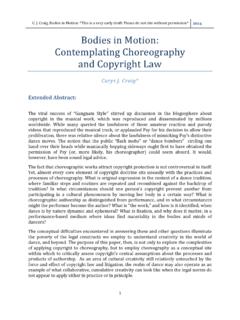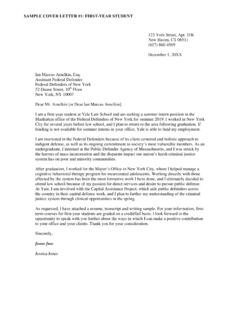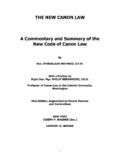Transcription of THE COMMON LAW AND CIVIL LAW TRADITIONS
1 Most nations today follow one of two major le-gal TRADITIONS : COMMON law or CIVIL law. The COMMON law tradition emerged in England during the Middle Ages and was applied within British colonies across continents. The CIVIL law tradition developed in continental Europe at the same time and was applied in the colonies of European impe-rial powers such as Spain and Portugal. CIVIL law was also adopted in the nineteenth and twentieth centuries by countries formerly possessing distinc-tive legal TRADITIONS , such as Russia and Japan, that sought to reform their legal systems in order to gain economic and political power comparable to that of Western European nation-states.
2 To an American familiar with the terminology and process of our legal system, which is based on Eng-lish COMMON law, CIVIL law systems can be unfamiliar and confusing. Even though England had many pro-found cultural ties to the rest of Europe in the Middle Ages, its legal tradition developed differently from that of the continent for a number of historical reasons, and one of the most fundamental ways in which they di-verged was in the establishment of judicial decisions as the basis of COMMON law and legislative decisions as the basis of CIVIL law. Before looking at the history, let s examine briefly what this means.
3 COMMON law is generally uncodified. This means that there is no comprehensive compilation of legal rules and statutes. While COMMON law does rely on some scattered statutes, which are legislative deci-sions, it is largely based on precedent, meaning the ju-dicial decisions that have already been made in simi-lar cases. These precedents are maintained over time through the records of the courts as well as historically documented in collections of case law known as year-books and reports. The precedents to be applied in the decision of each new case are determined by the pre-siding judge.
4 As a result, judges have an enormous role in shaping American and British law. COMMON law functions as an adversarial system, a contest between two opposing parties before a judge who moderates. A jury of ordinary people without legal training decides on the facts of the case. The judge then determines the appropriate sentence based on the jury s verdict. CIVIL Law, in contrast, is codified. Countries with CIVIL law systems have comprehensive, continuously updated legal codes that specify all matters capable of being brought before a court, the applicable procedure, and the appropriate punishment for each offense.
5 Such codes distinguish between different categories of law: substantive law establishes which acts are subject to criminal or CIVIL prosecution, procedural law establishes how to determine whether a particular action consti-tutes a criminal act, and penal law establishes the appro-priate penalty. In a CIVIL law system, the judge s role is to establish the facts of the case and to apply the provisions of the applicable code. Though the judge often brings the formal charges, investigates the matter, and decides on the case, he or she works within a framework es-tablished by a comprehensive, codified set of laws.
6 The judge s decision is consequently less crucial in shaping CIVIL law than the decisions of legislators and legal schol-ars who draft and interpret the codes. The following sections explore the historical roots of these COMMON LAW AND CIVIL LAW TRADITIONSA bove: Woodcut of a court scene from Praxis criminis persequendi, Jean Milles de Souvigny, 1541. The Robbins Collection. Historical Development of CIVIL LawThe term CIVIL law derives from the Latin ius civile, the law applicable to all roman cives or citizens. Its origins and model are to be found in the monumen-tal compilation of roman law commissioned by the Emperor Justinian in the sixth century CE.
7 While this compilation was lost to the West within decades of its creation, it was rediscovered and made the basis for le-gal instruction in eleventh-century Italy and in the six-teenth century came to be known as Corpus iuris civilis. Succeeding generations of legal scholars throughout Europe adapted the principles of ancient roman law in the Corpus iuris civilis to contemporary needs. Medieval scholars of Catholic church law, or canon law, were also influenced by roman law scholarship as they compiled existing religious legal sources into their own compre-hensive system of law and governance for the Church, an institution central to medieval culture, politics, and higher learning.
8 By the late Middle Ages, these two laws, CIVIL and canon, were taught at most universities and formed the basis of a shared body of legal thought COMMON to most of Europe. The birth and evolution of the medieval CIVIL law tradition based on roman law was thus integral to European legal development. It offered a store of legal principles and rules invested with the authority of ancient Rome and centuries of distinguished jurists, and it held out the possibility of a comprehensive legal code providing substantive and procedural law for all situations. As CIVIL law came into practice throughout Europe, the role of local custom as a source of law became increasingly important particularly as growing European states sought to unify and orga-nize their individual legal systems.
9 Throughout the early modern period, this desire generated schol-arly attempts to systematize scattered, disparate legal provisions and local customary laws and bring them into harmony with rational principles of CIVIL law and natural law. Emblematic of these attempts is the Dutch jurist Hugo Grotius 1631 work, Intro-duction to Dutch Jurisprudence, which synthesized roman law and Dutch customary law into a cohe-sive whole. In the eighteenth century, the reform-ing aspirations of Enlightenment rulers aligned with jurists desire to rationalize the law to produce comprehensive, systematic legal codes including Austria s 1786 Code of Joseph II and Complete CIVIL Code of 1811, Prussia s Complete Territorial Code of 1794, and France s CIVIL Code (known as the Na-poleonic Code) of 1804.
10 Such codes, shaped by the roman law tradition , are the models of today s CIVIL law THE COMMON LAW AND CIVIL LAW TRADITIONSA bove: Mosaic of Emperor Justinian I, 6th CE. Basilica of San Vitale, Ravenna, development of English COMMON LawEnglish COMMON law emerged from the changing and centralizing powers of the king during the Middle Ages. After the Norman Conquest in 1066, medieval kings began to consolidate power and establish new institutions of royal authority and justice. New forms of legal action established by the crown functioned through a system of writs, or royal orders, each of which provided a specific remedy for a specific wrong.
















